|
Click pictures for a larger version.
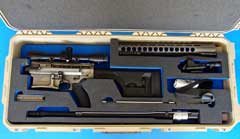
The DRD Kivaari disassembled in its hard
carrying case: note that the receiver is stowed with the scope
mounted. This allows the
scope to theoretically remain zeroed.
If possible it is always preferable to check zero. However, based on Thompson assembling and disassembling
the rifle three times, then firing groups, it does hold zero
well.
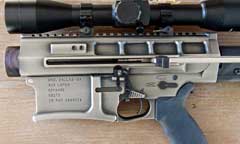
Close up of the Kivaari with the
bolt locked open to allow assembly or disassembly.
The bolt hold open/release lever is located above the
trigger guard. Note also
the selector switch.
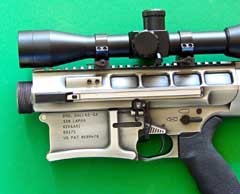
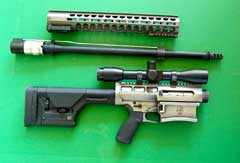
Kivaariís three main components prior
to assembly; note that the thread protector will have to be
removed from the barrel threads prior to assembly.
The M1913 rail at the front of the hand guard will take
the bipod.

Kivaari assembled and ready to take the
shot.
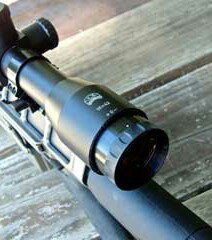
IOR Valdada 16-x42 offers good
long-range visibility, excellent clarity, and a highly usable
reticle.
|
|
I
became interested in the .338 Lapua Magnum (LM) Sniping Rifle
primarily because various anti-terrorist units with which I had
contact adopted it and were singing its praises.
I wanted to determine if it really is as deadly at long
range as its advocates claim. Until recently, a .338 LM held the
record for the longest kill of 2,475 meters in Afghanistan. That
record had stood since 2009, but in May, 2017, it was surpassed
by over 1,000 meters by a shot of 3,540 meters in the Iraqi
Civil War with a MacMillan TAC-50.Still, the .338 LM sniping
rifle is a very serious weapon.
Generally,
the .338 LM is lighter and shorter than the .50 BMG sniping
rifle and has less recoil. It
was designed as an anti-personnel rifle capable of punching
through body armor at 1,000 meters.
Unlike the .50 BMG, which is considered an anti-material
rifle, the .338 LM was not intended for use against vehicles or
other equipment. Having said that, I have fired .338 LM rounds
through concrete blocks to hit a target. It has also been used
to take enemy personnel in vehicles.
It can be used to destroy sensitive
communications/computer equipment or enemy weapons such as
machine guns or missile launchers.Any sensitive electronic gear
can be devastated with a 250 or 300 grain .338 LM bullet. Basically,
itís versatile; itís designed to eliminate bad guys but it
can also eliminate bad guysí equipment.
The
.338 LM sniping rifle has proven especially appealing to special
operations snipers who may have to hike some distance to their hide. Even
if inserted by helicopter, vehicle, or small boat, the shooting
position will likely entail a slog.
And, many snipers using the .338 LM have operated in
Afghanistan where long shots may be across mountainous terrain,
mountainous terrain that requires climbing.
As
a result, development of lighter, more compact .338 LM sniping
rifles has been a priority for manufacturers of precision
rifles. The usual fixes
have been shorter barrels, which degrade the long-range
performance of the .338 LM cartridge or folding stocks, which
often actually add to the rifleís weight.
DRD
Tactical offers another approach. DRD is known for its
high-quality takedown AR-type rifles so I was very intrigued
when I learned that they offer a takedown .338 Lapua sniping rifle. Not
only that, but itís a self-loader! Designated the KivaarióFinnish for rifleóthis is a .338 LM with
some real advantages. Obviously,
the fact it breaks down into three main partsóreceiver/stock
with scope mounted, barrel, and forearm makes it easier to
transport. Its semi-auto
action is also appealing. Once in a hide, the less movement a
sniper has to make the better. A skilled rifleman can work a
bolt smoothly, but not having to work a bolt is even smoother. Faster
repeat shots are also possible with a self-loader. Another
consideration with a self-loading .338 will be less noticeable
recoil.
Although
the hard case that is standard with the Kivaari is excellent and
may be moved around readily using its rollers, it is not optimum
for a sniper that has to transport his rifle into shooting
position. Therefore, as
an alternative, DRD offers a backpack designed to carry the
disassembled rifle. For
military snipers, especially, that looks like the best option.
There
could be another advantage of using the backpack. The hard case
has cutouts for the components of the Kivaari system. The cutout for the scope when mounted on the receiver puts some
restrictions on choice of optic, though the restrictions may be
more on the mount. The
scope must fit the dimensions of the cutout or the user must
alter the cutout. Height
of mount and length of scope are important factors, as is the
size of the scopeís objective.
If the right scope/mount combo is used, a long-range
variable suitable for shooting to 1,500 meters may be mounted. But,
anyone purchasing a Kivaari must realize that some optical
planning will be necessary.The backpack seems to offer a little
more leeway in choice of scope, but I must admit that I have
only seen photos of the backpack and have not tried it.
Another
factor in mounting the scope arises with the way the forearm
slips into place around the barrel. There must be room to fit it
flush against the top rail.
Thus, the objective has to offer at least minimal
clearance above the top rail. I
found that with the 50mm lenses of some of the long-range scopes
I normally use on .338 LM rifles and the mounts I normally use,
I could not get that clearance.
Fortunately,
I knew that IOR-Valdada, which offers excellent scopes, had a
long-range 16X fixed power scope that only has a 42mm objective. I
assumed that it would work with a set of the 30mm medium rings I
often use, and it did.
This
Valdada 16x42 Tactical Scope uses the MP-8 reticle, which I have
found works well for precision shooting at longer ranges.
Though these days, I normally use a laser range-finder
and/or a program such as GeoBallistics on my Mini IPad, the MP-8
reticle is also useful for ranging.
Iíve always used variables on .338 LM rifles so was
interested to see how I liked the fixed power 16X scope; I like
it. The focus
allows quick adjustment for closer range (40 yds) to infinity,
and I find it crystal clear.So far, Iíve been testing the Kivaari
at 300 yards and less to check functioning and get it
zeroed.When I can get access to range that will allow longer
range shooting, I may find that I miss the higher magnification
on some of my variable scopes. Having said that, I have a
variable with 20X the highest magnification that Iíve used for
years on .338 LM rifles so I may not notice that much
difference.
Another
reason I like Valdada scopes is that they are precise in adjustment. The
16x42 uses 0.1 Mrad clicks at 100 yards (roughly one/third of an
inch). I managed to
get the scope initially zeroed at 200 yards with 12 rounds. When shooting a .338 LM where each round costs $3.00 or more that
is a real advantage. By
the way, I know some writers have written articles on zeroing
with one or two shots. They must be smarter than me!Of course,
precise adjustments are vital for a scope on a .338 LM rifle to
get precise shot placement.
I
have some experience with DRD takedown rifles so already know
the drill to get one ready for action. That speeded things up a
bit when learning to use the Kivaari. Once the components are
out of the case, to ready the Kivaari to shoot, the process is:
-
Lock
the bolt back
-
Remove
the thread protector from the barrel
-
Align
the gas tube and insert it and the barrel into the receiver;
then tighten the barrel collar down
-
Use
the spanner wrench to fully tighten the barrel collar
-
Open
the lever and the cross pin on the forearm; then slide it
over the barrel and lock in place
-
If
a bipod is to be used (and I recommend it on the Kivaari),
attach it and tighten it down. NOTE: the bipod cannot be
pre-attached if carrying the Kivarri in the hard case; in a
backpack it probably could
-
Insert
a loaded magazine
-
Ready
for action
After
assembling the Kivaari 10 or 11 times, I have my time down to
2:45 for the whole process including attaching the bipod, which
requires tightening a lever to lock the Harris HBRMS bipod with
MIM RotoPod adapter into place on the M1913 rail. Note that the
MIM RotoPod adapter allows faster installation than other types
of adapters Iíve used. Based
on my learning curve on other DRD Tactical takedowns, I predict
Iíll cut that by 30 seconds or more.
And, letís face it; normally, fast assembly of a sniper
rifle is not going to be an issue.
Another
noteworthy point is that the Kivaari held zero quite close when
disassembled and reassembled, but I was only checking that at
100 yards. Iíll check
that again when I can shoot it at 500 yards or more.
As
I already mentioned, zeroing the Kivaari at a 100 yards was
fast. However, since the rifle is a .338 LM, I would normally
zero it at 300 yards. That
took another 9 shots to get it exactly where I wanted it.
By the way, as the Kivaari is a self-loader, I was
curious if the brass would be ejected far and wide, but it wasn't. As
a lot of .338 LM shooters reload that is a positive.
Among
other positive features of the Kivaari I discovered when
shooting it are that its Magpul PRS stock allows adjustment for
comfort and cheek weld. Based on past experience, getting the
stock right is extremely important with a .338 LM rifle.
The semi-auto action combined with the well-designed
stock made recoil entirely comfortable. In the past when testing
some bolt-action .338 rifles, if I were going to fire more than
20 rounds I made it a point to wear my ballistic vest to spread
the recoil. With the
Kivaari, sessions of 50 rounds or so wearing a light shirt have
not caused any discomfort.
I
did not chronograph any of the rounds I fired through the
Kivaari: CorBon 225-grain T-DPX, Black Hills 250-grain Sierra,
and Nammo 250-grain Scenar functioned reliably in the Kivaari.
I would assume, though, that velocities and range would
be down a bit with the Kivaariís 24-inch barrel compared to
the 27-inch barrels on a lot of .338 bolt guns.
As the Kivaari is a self-loader, accuracy is not going to
be as good as with the typical .338 LM bolt guns.
DRD advertises 1-MOA with Lapua (Nammo) ammunition.I
found that to be valid in my test groups.
For comparison, I have shot 1/2-MOA with various .338
Lapua bolt guns.
That
difference in accuracy will be magnified at longer ranges. For
example, at 1,000 yards, my SAKO TRG-42 or Steyr SSG 08 .338
Laupa rifles will put three shots into 5 inches if I really do
my job, which I rarely do!However, the Kivaari would stretch
that group to 10 inches, assuming the shooter held true.
Tactically,
that would seem to suit the Kivaari better to give overwatch/support
at ranges between 500 and 1,000 meters where it can penetrate
barricades or vehicles. The Kivaari comes with a pair of
10-round magazines; thatís 20-rounds of ready ammo without
purchasing additional magazines.
The
Kivaari may not offer the precise shot placement at extreme
range that some of the bolt-action .338 LM rifles do, but it
offers portability and fast follow-up shots.
It would seem especially well-suited to use as a
long-range overwatch rifle, one that the operator may carry
readily into combat, assemble and deploy, and deliver quick and
precise support fire.
For
more information see:
http://drdtactical.com/product/kivaari-338/
http://www.valdada.com/16x42-30mm-tactical-mil-mil-sf-mp-8-reticle/
http://www.harrisbipods.com/HBRMS.html
http://www.mim-mfg.com/
Leroy
Thompson
  
Got something to say about this article?
Want to agree (or disagree) with it? Click the following link to
go to the GUNBlast Feedback Page.
|
|
Click pictures for a larger version.
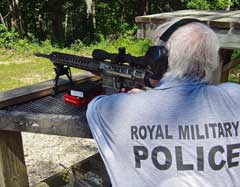
The Kivaari is a very comfortable
rifle to shoot, allowing good shooting position and cheek weld
due to the adjustable stock.

Compact but powerful, the IOR 16 power
scope allows quick and precise adjustments for windage and
elevation.
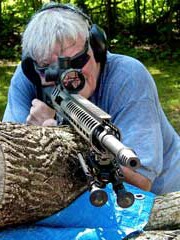
The Kivaariís handiness, especially for a .338 LM sniping rifle, and low recoil allow use of an
improvised rest.
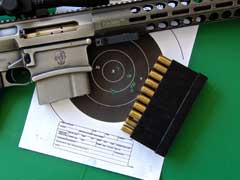
2-inch, 200-yard 5-inch group using
250-grain Lapua ammo is typical for the Kivaari, which is
advertised as a one-MOA rifle.
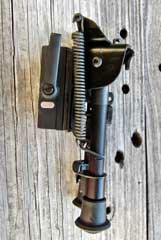
The RotoPod adaptor for the Harris
bipod that aids in fast attachment.
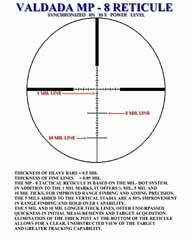
The
MP 8 reticle on the Valdada 16x42 scope.
|
![]()